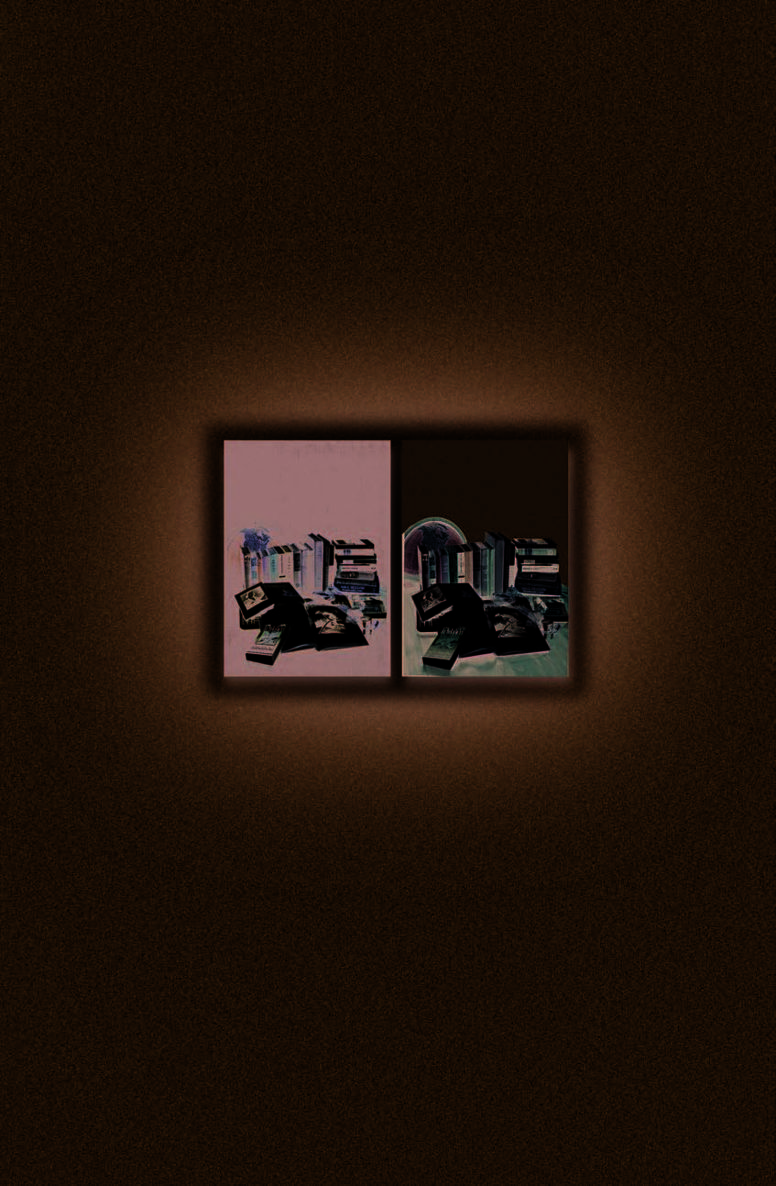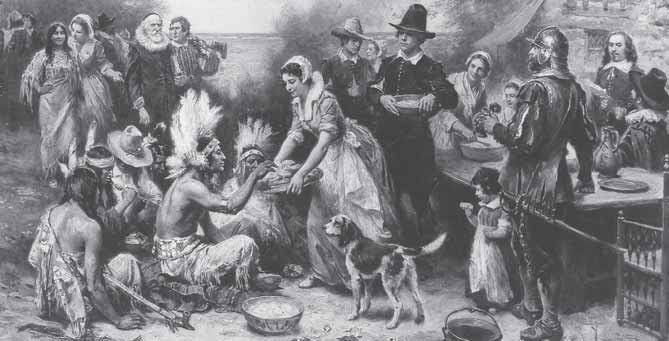



06-0823 AmLit Cover 12/15/06 10:59 AM Page 1
OUTLINE OF AMERICAN LITERA
AMERIC
Outline of
AN
LITERATURE
U.S. DEPARTMENT OF STATE /
❦
BUREAU OF INTERNATIONAL INFORMATION PROGRAMS
http://usinfo.state.gov
REVISED EDITION
REVISED
EDITION
TURE

AMERICAN
LITERATURE
REVISED EDITION
EARLY AMERICAN
PUBLISHED BY THE UNITED STATES
DEPARTMENT OF STATE
AND COLONIAL PERIOD TO 1776 3
STAFF
DEMOCRATIC ORIGINS
WRITTEN BY: KATHRYN VANSPANCKEREN
AND REVOLUTIONARY WRITERS,
EXECUTIVE EDITOR: GEORGE CLACK
1776-1820
MANAGING EDITOR: PAUL MALAMUD
14
CONTRIBUTING EDITOR: KATHLEEN HUG
ART DIRECTOR / DESIGNER:
T
T
HE ROMANTIC PERIOD, 1820-1860:
HADDEUS A. MIKSINSKI, JR.
PICTURE EDITOR: JOANN STERN
ESSAYISTS AND POETS 26
Front Cover: © 1994 Christopher Little
THE ROMANTIC PERIOD,
1820-1860: FICTION
ABOUT THE AUTHOR
36 Kathryn VanSpanckeren
is Professor of English at the
THE RISE OF REALISM:
University of Tampa, has
1860-1914
lectured in American literature
47 widely abroad, and is former
director of the Fulbright-spon-
MODERNISM AND
sored Summer Institute in
E
American Literature for
XPERIMENTATION: 1914-1945 60
international scholars. Her
publications include poetry and
A
scholarship. She received
MERICAN POETRY,
her Bachelors degree from the
1945–1990: THE ANTI-TRADITION
University of California,
79
Berkeley, and her Ph.D. from
Harvard University.
AMERICAN PROSE,
1945–1990:
REALISM AND EXPERIMENTATION 97
CONTEMPORARY AMERICAN POETRY 121
CONTEMPORARY AMERICAN LITERATURE 136
GLOSSARY 157
INDEX 163
The following text materials may not be reproduced without permission of the copyright holder.
“In a Station of the Metro” (page 63) by Ezra Pound. From Ezra Pound Personae.
Copyright © 1926 by Ezra Pound. Translated and reprinted by permission of New Directions Publishing Corporation.
“Stopping by Woods on a Snowy Evening” (page 65) by Robert Frost. From The Poetry of Robert Frost, edited by Edward Connery Lathem. Copyright 1923. © 1969 by Henry Holt and Co., Inc., © 1951 by Robert Frost. Reprinted and translated by permission of Henry Holt and Co., Inc.
“Disillusionment of Ten O’Clock” (page 66) by Wallace Stevens. From Selected Poems by Wallace Stevens. Copyright 1923 and renewed 1951 by Wallace Stevens. Reprinted by permission of Alfred A. Knopf, Inc.
“The Red Wheelbarrow” (page 66) and “The Young Housewife” (page 67) by William Carlos Williams. Collected Poems. 1909-1939. Vol. I. Copyright 1938 by New Directions Publishing Corp. Reprinted by permission of New Directions.
“The Negro Speaks of Rivers” (page 69) by Langston Hughes. From Selected Poems by Langston Hughes. Copyright 1926 by Alfred A. Knopf, Inc. and renewed 1954 by Langston Hughes. Reprinted by permission of the publisher.
“The Death of the Ball Turret Gunner” (page 80) by Randall Jarrell from Randall Jarrell: Selected Poems; © 1945 by Randall Jarrell, © 1990 by Mary Von Schrader Jarrell, published by Farrar Straus & Giroux. Permission granted by Rhoda Weyr Agency, New York.
"The Wild Iris" (page 125) from The Wild Iris by Louise Glück. Copyright © 1993 by Louise Glück. Reprinted by permission of HarperCollins Publishers Inc.
"Chickamauga" (page 126) from Chickamauga by Charles Wright. Copyright © 1995 by Charles Wright. Reprinted by permission of Farrar, Straus and Giroux, LLC.
"To The Engraver of my Skin" (page 129) from Source by Mark Doty. Copyright © 2001 by Mark Doty. Reprinted by permission of HarperCollins Publishers Inc.
"Mule Heart" (page 130) from The Lives of The Heart by Jane Hirshfield. Copyright © 1997
by Jane Hirshfield. Reprinted by permission of HarperCollins Publishers Inc.
"The Black Snake" (page 131) copyright © 1979 by Mary Oliver. Used with permission of the Molly Malone Cook Literary Agency.
"The Dead" (page 132) is from Questions About Angels by Billy Collins, © 1991. Reprinted by permission of the University of Pittsburgh Press.
"The Want Bone" (page 133) from The Want Bone by Robert Pinsky. Copyright © 1991 by Robert Pinsky. Reprinted by permission of HarperCollins Publishers Inc.
Yusef Komunyakaa, "Facing It" (page 134) from Dien Cai Dau in Pleasure Dome: New and Collected Poems, © 2001 by Yusef Komunyakaa and reprinted by permission of Wesleyan University Press.
A number of the illustrations appearing in this volume are also copyrighted, as is indicated on the illustrations themselves. These may not be reprinted without the permission of the copyright holder.
The opinions expressed in this publication do not necessarily reflect the views or policies of the U.S. government.
2
some tales of a high god or culture were told
elsewhere. However, there are no long, stan-
CHAPTER dardized religious cycles about one supreme divinity. The closest equivalents to Old World
spiritual narratives are often accounts of
shamans’ initiations and voyages. Apart from
these, there are stories about culture heroes
1
such as the Ojibwa tribe’s Manabozho or the
EARLY AMERICAN AND
Navajo tribe’s Coyote. These tricksters are treat-
COLONIAL PERIOD TO 1776 ed with varying degrees of respect. In one tale they may act like heroes, while in another they
merican literature begins with the orally
may seem selfish or foolish. Although past
transmitted myths, legends, tales, and
authorities, such as the Swiss psychologist Carl
Alyrics (always songs) of Indian cultures. Jung, have deprecated trickster tales as express-There was no written literature among the more
ing the inferior, amoral side of the psyche, con-
than 500 different Indian languages and tribal
temporary scholars — some of them Native
cultures that existed in North America before
Americans — point out that Odysseus and
the first Europeans arrived. As a result, Na-
Prometheus, the revered Greek heroes, are
tive American oral literature is quite diverse.
essentially tricksters as well.
Narratives from quasi-nomadic hunting cultures
Examples of almost every oral genre can be
like the Navaho are different from stories of set-
found in American Indian literature: lyrics,
tled agricultural tribes such as the pueblo-
chants, myths, fairy tales, humorous anecdotes,
dwelling Acoma; the stories of northern lakeside
incantations, riddles, proverbs, epics, and leg-
dwellers such as the Ojibwa often differ radical-
endary histories. Accounts of migrations and an-
ly from stories of desert tribes like the Hopi.
cestors abound, as do vision or healing songs and
Tribes maintained their own religions — wor-
tricksters’ tales. Certain creation stories are
shipping gods, animals, plants, or sacred per-
particularly popular. In one well-known creation
sons. Systems of government ranged from
story, told with variations among many tribes, a
democracies to councils of elders to theocra-
turtle holds up the world. In a Cheyenne version,
cies. These tribal variations enter into the oral
the creator, Maheo, has four chances to fashion
literature as well.
the world from a watery universe. He sends four
Still, it is possible to make a few generaliza-
water birds diving to try to bring up earth from
tions. Indian stories, for example, glow with rev-
the bottom. The snow goose, loon, and mallard
erence for nature as a spiritual as well as physi-
soar high into the sky and sweep down in a dive,
cal mother. Nature is alive and endowed with
but cannot reach bottom; but the little coot, who
spiritual forces; main characters may be animals
cannot fly, succeeds in bringing up some mud in
or plants, often totems associated with a tribe,
his bill. Only one creature, humble Grandmother
group, or individual. The closest to the Indian
Turtle, is the right shape to support the mud
sense of holiness in later American literature is
world Maheo shapes on her shell — hence the
Ralph Waldo Emerson’s transcendental “Over-
Indian name for America, “Turtle Island.”
Soul,” which pervades all of life.
The songs or poetry, like the narratives, range
The Mexican tribes revered the divine
from the sacred to the light and humorous:
Quetzalcoatl, a god of the Toltecs and Aztecs, and There are lullabies, war chants, love songs, and
3
special songs for children’s games, gambling,
English, Spanish, or French. The first European
various chores, magic, or dance ceremonials.
record of exploration in America is in a
Generally the songs are repetitive. Short poem-
Scandinavian language. The Old Norse Vinland
songs given in dreams sometimes have the clear
Saga recounts how the adventurous Leif Ericson imagery and subtle mood associated with
and a band of wandering Norsemen settled
Japanese haiku or Eastern-influenced imagistic
briefly somewhere on the northeast coast of
poetry. A Chippewa song runs:
America — probably Nova Scotia, in Canada —
in the first decade of the 11th century, almost 400
A loon I thought it was
years before the next recorded European dis-
But it was
covery of the New World.
My love’s
The first known and sustained contact be-
splashing oar.
tween the Americas and the rest of the world,
however, began with the famous voyage of an
Vision songs, often very short, are another dis-
Italian explorer, Christopher Columbus, funded
tinctive form. Appearing in dreams or visions,
by the Spanish rulers Ferdinand and Isabella.
sometimes with no warning, they may be healing,
Columbus’s journal in his “Epistola,” printed in
hunting, or love songs. Often they are personal,
1493, recounts the trip’s drama — the terror of
as in this Modoc song:
the men, who feared monsters and thought they
might fall off the edge of the world; the near-
I
mutiny; how Columbus faked the ships’ logs so
the song
the men would not know how much farther they
I walk here.
had travelled than anyone had gone before; and
the first sighting of land as they neared America.
Indian oral tradition and its relation to American Bartolomé de las Casas is the richest source
literature as a whole is one of the richest and least of information about the early contact between
explored topics in American studies. The Indian
American Indians and Europeans. As a young
contribution to America is greater than is often
priest he helped conquer Cuba. He transcribed
believed. The hundreds of Indian words in every-
Columbus’s journal, and late in life wrote a long, day American English include “canoe,” “tobacco,”
vivid History of the Indians criticizing their
“potato,” “moccasin,” “moose,” “persimmon,”
enslavement by the Spanish.
“raccoon,” “tomahawk,” and “totem.” Con-
Initial English attempts at colonization were
temporary Native American writing, discussed in
disasters. The first colony was set up in 1585 at
chapter 8, also contains works of great beauty.
Roanoke, off the coast of North Carolina; all its
colonists disappeared, and to this day legends
THE LITERATURE OF EXPLORATION
are told about blue-eyed Croatan Indians of the
ad history taken a different turn, the
area. The second colony was more permanent:
United States easily could have been a
Jamestown, established in 1607. It endured star-
Hpart of the great Spanish or French over- vation, brutality, and misrule. However, the liter-seas empires. Its present inhabitants might
ature of the period paints America in glowing
speak Spanish and form one nation with Mexico,
colors as the land of riches and opportunity.
or speak French and be joined with Canadian
Accounts of the colonizations became world-
Francophone Quebec and Montreal.
renowned. The exploration of Roanoke was care-
Yet the earliest explorers of America were not
fully recorded by Thomas Hariot in A Brief and 4
True Report of the New-Found Land of Virginia
is important to recognize its richly cosmopolitan
(1588). Hariot’s book was quickly translated into
beginnings.
Latin, French, and German; the text and pictures
were made into engravings and widely repub-
THE COLONIAL PERIOD IN
lished for over 200 years.
NEW ENGLAND
The Jamestown colony’s main record, the writ-
ings of Captain John Smith, one of its leaders, is It is likely that no other colonists in the history of the world were as intellectual as the
the exact opposite of Hariot’s accurate, scientif-
Puritans. Between 1630 and 1690, there were
ic account. Smith was an incurable romantic, and
as many university graduates in the northeastern
he seems to have embroidered his adventures.
section of the United States, known as New
To him we owe the famous story of the Indian
England, as in the mother country — an astound-
maiden, Pocahontas. Whether fact or fiction, the
ing fact when one considers that most educated
tale is ingrained in the American historical imag-
people of the time were aristocrats who were
ination. The story recounts how Pocahontas,
unwilling to risk their lives in wilderness condi-
favorite daughter of Chief Powhatan, saved
tions. The self-made and often self-educated
Captain Smith’s life when he was a prisoner of
Puritans were notable exceptions. They wanted
the chief. Later, when the English persuaded
education to understand and execute God’s will
Powhatan to give Pocahontas to them as a
as they established their colonies throughout
hostage, her gentleness, intelligence, and beauty
New England.
impressed the English, and, in 1614, she married
The Puritan definition of good writing was that
John Rolfe, an English gentleman. The marriage
which brought home a full awareness of the im-
initiated an eight-year peace between the col-
portance of worshipping God and of the spiritual
onists and the Indians, ensuring the survival of
dangers that the soul faced on Earth. Puritan
the struggling new colony.
style varied enormously — from complex meta-
In the 17th century, pirates, adventurers, and
physical poetry to homely journals and crushing-
explorers opened the way to a second wave of
ly pedantic religious history. Whatever the style
permanent colonists, bringing their wives, chil-
or genre, certain themes remained constant. Life
dren, farm implements, and craftsmen’s tools.
was seen as a test; failure led to eternal damna-
The early literature of exploration, made up of
tion and hellfire, and success to heavenly bliss.
diaries, letters, travel journals, ships’ logs, and This world was an arena of constant battle
reports to the explorers’ financial backers —
between the forces of God and the forces of
European rulers or, in mercantile England and
Satan, a formidable enemy with many disguises.
Holland, joint stock companies — gradually was
Many Puritans excitedly awaited the “millenni-
supplanted by records of the settled colonies.
um,” when Jesus would return to Earth, end
Because England eventually took possession of
human misery, and inaugurate 1,000 years of
the North American colonies, the best-known
peace and prosperity.
and most-anthologized colonial literature is
Scholars have long pointed out the link
English. As American minority literature contin-
between Puritanism and capitalism: Both rest on
ues to flower in the 20th century and American
ambition, hard work, and an intense striving for
life becomes increasingly multicultural, scholars
success. Although individual Puritans could not
are rediscovering the importance of the conti-
know, in strict theological terms, whether they
nent’s mixed ethnic heritage. Although the story
were “saved” and among the elect who would go
of literature now turns to the English accounts, it to heaven, Puritans tended to feel that earthly
5

Painting courtesy Smithsonian Institution
“The First Thanksgiving,” a painting by J.L.G. Ferris, depicts America’s early settlers and Native Americans celebrating a bountiful harvest.
success was a sign of election. Wealth and status
Like most Puritans, they interpreted the Bible
were sought not only for themselves, but as literally. They read and acted on the text of the welcome reassurances of spiritual health and
Second Book of Corinthians — “Come out from
promises of eternal life.
among them and be ye separate, saith the Lord.”
Moreover, the concept of stewardship encour-
Despairing of purifying the Church of England
aged success. The Puritans interpreted all things
from within, “Separatists” formed underground
and events as symbols with deeper spiritual
“covenanted” churches that swore loyalty to the
meanings, and felt that in advancing their own
group instead of the king. Seen as traitors to the profit and their community’s well-being, they
king as well as heretics damned to hell, they
were also furthering God’s plans. They did not
were often persecuted. Their separation took
draw lines of distinction between the secular and
them ultimately to the New World.
religious spheres: All of life was an expression of the divine will — a belief that later resurfaces in William Bradford (1590-1657)
Transcendentalism.
William Bradford was elected governor of
In recording ordinary events to reveal their
Plymouth in the Massachusetts Bay Colony short-
spiritual meaning, Puritan authors commonly
ly after the Separatists landed. He was a deeply
cited the Bible, chapter and verse. History was a
pious, self-educated man who had learned sever-
symbolic religious panorama leading to the
al languages, including Hebrew, in order to “see
Puritan triumph over the New World and to God’s
with his own eyes the ancient oracles of God in
kingdom on Earth.
their native beauty.” His participation in the
The first Puritan colonists who settled New
migration to Holland and the Mayflower voyage England exemplified the seriousness of Refor-to Plymouth, and his duties as governor, made
mation Christianity. Known as the “Pilgrims,”
him ideally suited to be the first historian of his they were a small group of believers who had
colony. His history, Of Plymouth Plantation
migrated from England to Holland — even then
(1651), is a clear and compelling account of the
known for its religious tolerance — in 1608, dur-
colony’s beginning. His description of the first
ing a time of persecutions.
view of America is justly famous:
6
Being thus passed the vast ocean, and a sea
husband eventually became governor of the
of troubles...they had now no friends to wel-
Massachusetts Bay Colony, which later grew into
come them nor inns to entertain or refresh
the great city of Boston. She preferred her long,
their weatherbeaten bodies; no houses or
religious poems on conventional subjects such
much less towns to repair to, to seek for
as the seasons, but contemporary readers most
succor...savage barbarians...were readier to
enjoy the witty poems on subjects from daily life
fill their sides with arrows than otherwise.
and her warm and loving poems to her husband
And for the reason it was winter, and they
and children. She was inspired by English meta-
that know the winters of that country, know
physical poetry, and her book The Tenth Muse
them to be sharp and violent, and subject to
Lately Sprung Up in America (1650) shows the cruel and fierce storms...all stand upon
influence of Edmund Spenser, Philip Sidney, and
them with a weatherbeaten face, and the
other English poets as well. She often uses elab-
whole country, full of woods and thickets,
orate conceits or extended metaphors. “To My
represented a wild and savage hue.
Dear and Loving Husband” (1678) uses the ori-
ental imagery, love theme, and idea of compari-
radford also recorded the first document
son popular in Europe at the time, but gives
of colonial self-governance in the
these a pious meaning at the poem’s conclusion:
BEnglish New World, the “Mayflower
Compact,” drawn up while the Pilgrims were still
If ever two were one, then surely we.
on board ship. The compact was a harbinger of
If ever man were loved by wife, then thee;
the Declaration of Independence to come a
If ever wife was happy in a man,
century and a half later.
Compare with me, ye women, if you can.
Puritans disapproved of such secular amuse-
I prize thy love more than whole mines of gold
ments as dancing and card-playing, which were
Or all the riches that the East doth hold.
associated with ungodly aristocrats and immoral
My love is such that rivers cannot quench,
living. Reading or writing “light” books also fell Nor ought but love from thee, give recompense.
into this category. Puritan minds poured their
Thy love is such I can no way repay,
tremendous energies into nonfiction and pious
The heavens reward thee manifold, I pray.
genres: poetry, sermons, theological tracts, and
Then while we live, in love let’s so persevere
histories. Their intimate diaries and meditations
That when we live no more, we may live ever.
record the rich inner lives of this introspective
and intense people.
Edward Taylor (c. 1644-1729)
Like Anne Bradstreet, and, in fact, all of New
Anne Bradstreet (c. 1612-1672)
England’s first writers, the intense, brilliant poet The first published book of poems by an
and minister Edward Taylor was born in England.
American was also the first American bo









